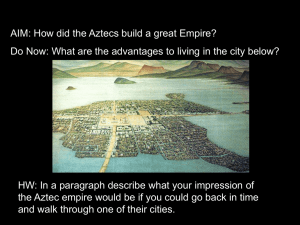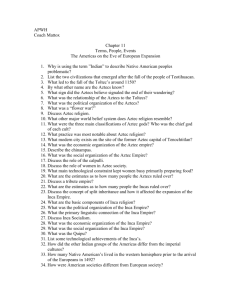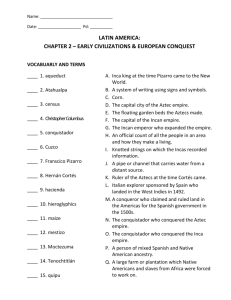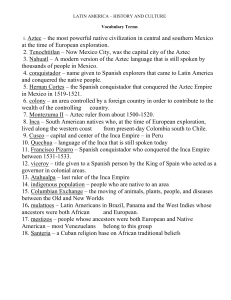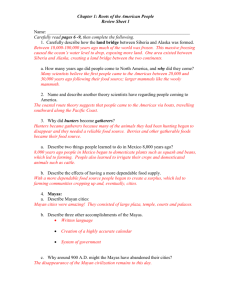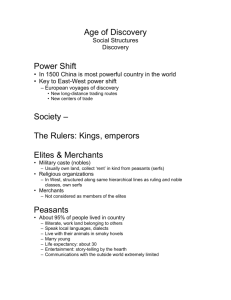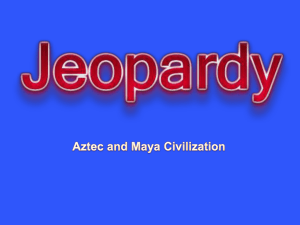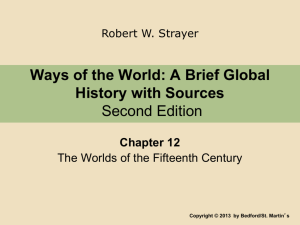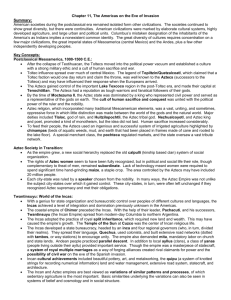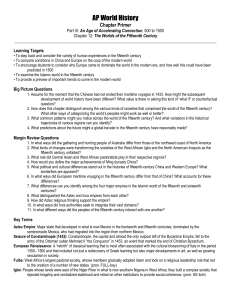Voyages Of Discovery
advertisement
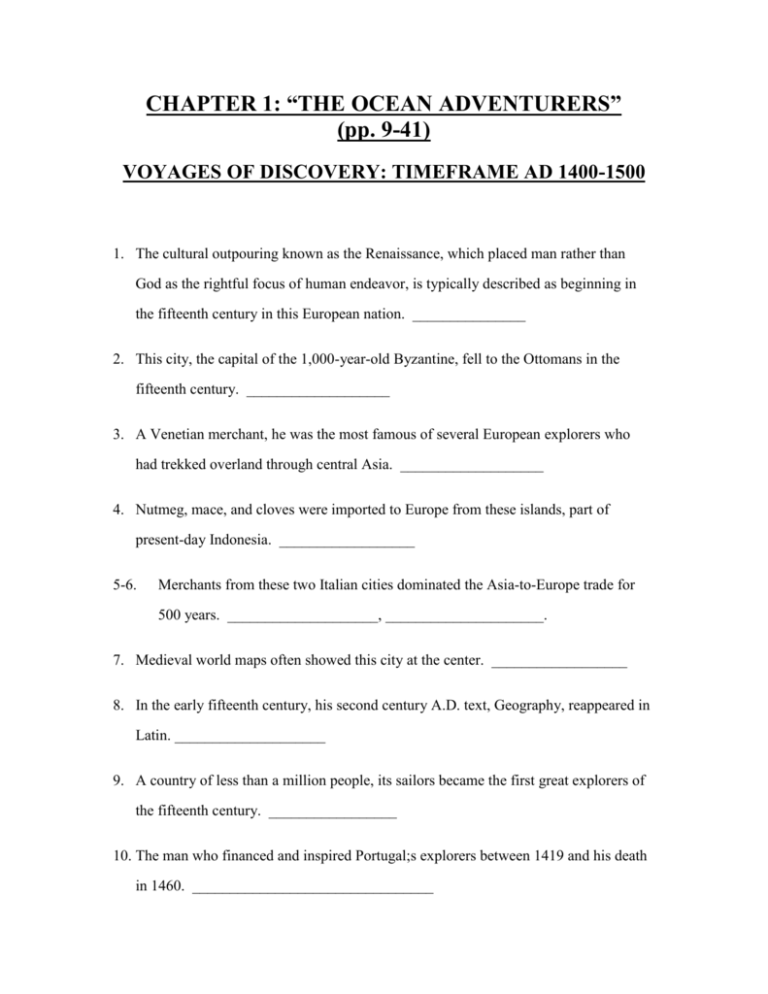
CHAPTER 1: “THE OCEAN ADVENTURERS” (pp. 9-41) VOYAGES OF DISCOVERY: TIMEFRAME AD 1400-1500 1. The cultural outpouring known as the Renaissance, which placed man rather than God as the rightful focus of human endeavor, is typically described as beginning in the fifteenth century in this European nation. _______________ 2. This city, the capital of the 1,000-year-old Byzantine, fell to the Ottomans in the fifteenth century. ___________________ 3. A Venetian merchant, he was the most famous of several European explorers who had trekked overland through central Asia. ___________________ 4. Nutmeg, mace, and cloves were imported to Europe from these islands, part of present-day Indonesia. __________________ 5-6. Merchants from these two Italian cities dominated the Asia-to-Europe trade for 500 years. ____________________, _____________________. 7. Medieval world maps often showed this city at the center. __________________ 8. In the early fifteenth century, his second century A.D. text, Geography, reappeared in Latin. ____________________ 9. A country of less than a million people, its sailors became the first great explorers of the fifteenth century. _________________ 10. The man who financed and inspired Portugal;s explorers between 1419 and his death in 1460. ________________________________ 11. Bartolomew Dias reached and named this cape in 1487; he incorrectly believed it was the southern tip of South Africa. __________________ 12. The island in the Bahamas where Columbus originally sighted land on his first voyage in 1492. ______________________ 13-14. This 1494 treaty in effect divided the undiscovered world between Portugal and Spain, giving Spain claim to the lands west of the Atlantic Ocean demarcation line. ______________________________ That this still-to-be-discovered coast extended into the Portuguese sphere resulted in this nation becoming a Portuguese enclave in an otherwise Spanish South American continent. ___________________ 15. The town of Christopher Columbus’s birth. ________________ 16-17. The rulers of Spain who sponsored Columbus’s 1492 voyage. ______________, _____________________. 18. The term by which Columbus named the inhabitants of the land he discovered, an indication that he believed he had reached the Orient. _____________ 19. The explorer after whom the Americas were named. _______________________ 20. A century before the Portuguese arrived, this Chinese commander had sailed the Indian Ocean in seven different naval expeditions. _________________ 21. His Spanish-sponsored expedition of 1519 was the first to circumnavigate the globe. ___________________________ 22. This classical Greek philosopher had suggested that somewhere in distant latitudes there was an unknown southern land, a “terra australis incognita.” ___________ TRUE OR FALSE 23. Most geographers at the beginning of the fifteenth century still believed the world was flat. _____ 24. Columbus died in 1506 still unaware that he had revealed an entirely new continent. ______ CHAPTER 2: “THE ITALIAN RENAISSANCE” (pp. 43-73) VOYAGES OF DISCOVERY: TIMEFRAME AD 1400-1500 1. The historical name given to the division that resulted in there being two rival fourteenth-century popes vying for legitimacy, one based in Rome and the other in Avignon, France. ____________ 2-6. Who were the five major powers who competed for control of the Italian peninsula at the beginning of the fifteenth century? ____________________, __________________, ________________, ____________________, ______________________. 7. The largest of these powers geographically, it controlled most of mainland Italy south of Rome as well as the islands of Sicily and Sardinia. _______________ 8. Florence’s cathedral, begun in 1296, was completed in 1436 by this architect. _______________________ 9. What was the name of Florence’s prized golden coin, first minted in the thirteenth century? ______________ 10. Derived from the Latin studia humanitatis, “studies of mankind,” it captured the Ranaissance’s concern for open-minded inquiry and a focus upon life on Earth rather than upon theological orthodoxy. _________________ 11. By 1353, this plague had killed an estimated one-third of the European population. ________________ 12. The wealthy powerbrokers whose family name became synonymous with the fortunes and politics of Renaissance Florence. ________________ 13. What was the official name for the rulers of Venice? _____________ 14. This Venetian cathedral, built in the eleventh century, is the city’s most famous landmark. __________________ 15. A peasant’s son from the Florence area, this early Renaissance painter experimented with a more realistic and less formalized style, introducing such new techniques as the use of foreshortening. _____________ 16. The decorated counters at which Italian moneylenders carried out their transactions has given to us this word for modern financial institutions. _______________ 17. The Florentine Renaissance artist who produced such masterpieces as the “Birth of Venus.” ___________________ 18. Whereas the universities of fifteenth-century Italy increasingly prepared students for such careers as lawyers, merchants, and court officials, European universities of the Medieval era had almost universally trained its students for this profession. ____________________ 19. Born in 1452 in a small village outside Florence, this illegitimate son of a lawyer would become a brilliant artist, inventor, naturalist, and engineer, and the acknowledged genius of the Renaissance era. ______________________ 20. Coming to power as the leader of Florence in the very late fifteenth century as a reaction to the excesses of such others as the Medicis and Cesare Borgia, this monk conducted a brief but fierce campaign to purge the republic of impiety, burning irreligious paintings on a huge “Bonfire of the Vanities,” before he himself was burned. ___________________________ 21. Born in 1469, this Florentine explored the realities of political power in The Prince, his manual for effective statecraft. ___________________ 22. His “David,” completed in 1440, was the first Renaissance-era freestanding sculpture of the naked human body. ___________________ TRUE OR FALSE 23. The city states of Renaissance Italy relied upon massive armies of volunteers and conscripts to provide defense and wage war against their neighbors. _________ 24. Such Renaissance-era Popes as Innocent VIII struggled to live simple, frugal, spiritual lives, and thus served as an obvious contrast to the spirit of the times, which seemed more concerned with worldly affairs and the pursuit of wealth. _____ 25. Those who today wear four-inch clogs would have been judged to have been in style in fifteenth-century Italy. _____ CHAPTER 3: “THE FALL OF CONSTANTINOPLE” (pp. 75-91) VOYAGES OF DISCOVERY: TIMEFRAME AD 1400-1500 1. Who sacked Constantinople in 1204? __________________________________ 2. Who was the Turkish sultan who captured Constantinople? ________________ 3. For hundreds of years, the defenders of Constantinople had used this flammable substance to devastating effect. _______________ CHAPTER 4: “BOHEMIA’S HOLY WARS” (pp. 93-121) VOYAGES OF DISCOVERY: TIMEFRAME AD 1400-1500 1. Prague was capital of what empire for much of the fourteenth century? ________________ 2. Attracted by its agricultural land and its mineral wealth, many immigrants of this nationality moved into Bohemia beginning in the eleventh century. ____________ 3. With the purchase of these, claimed the Church, a person could gain freedom from punishment for one’s sins. ___________________ 4. What was the name given to the practice of the buying and selling of church offices? __________________ 5. The name given to the factional divide in the Catholic Church that culminated in 1378, after which there were two rival popes – one based in Rome and the other in Avignon, France. _________________ 6. This Catholic doctrine contends that the bread and wine used in Holy Communion are converted into the Body and Blood of Christ. ______________ 7. A reformist Bohemian theologian who was burned at the stake in 1415 as a result of decisions made at the Council of Constance, he had criticized the church and its clergy for becoming corrupted by wealth. ___________________ 8. The taking of this at communion, previously reserved by the Roman Catholic Church to priests alone, was a key tenet of Hussite theology. ___________ 9. Who was thrown out the window in the 1419 “First Defenestration of Prague?” _____________________________ 10. The more radical of the major Hussite factions, they were largely peasants and were led into battle against the armies of the emperor and the pope by the landowner and professional soldier Jan Zizka. _____________________ 11. What German goldsmith is typically described as the inventor of the printing press? ___________________________ 12. True or False: The Chinese had developed printing as early as the eleventh century; that it was to have so much more marked an impact upon the West than the East is probably not a statement upon European ingenuity but upon the differences between the Western letter alphabet and the complexity of Chinese ideograms. _____ 13. Also known as the 42-Line Bible, it was issued in 1455 in a run of approximately 200 copies. _______________________ 14. What was the name given to the Latin translation of the Bible? ______________ CHAPTER 5: “THE LAST GREAT HINDU EMPIRE” (pp. 123-139) VOYAGES OF DISCOVERY: TIMEFRAME AD 1400-1500 1. The explorer Vasco da Gama, who made the first European landfall in India in 1498, was from what nation? ____________________ 2. Literally the “City of Victory,” this capital gave the name to the empire that dominated the southern part of the Indian subcontinent during the fifteenth and early sixteenth centuries. _____________________ 3. Beginning in the eighth century, Arabs had established control over this valley, the base for the subcontinent’s most ancient civilization. ______________ 4. Islamic conquerors from the North established a Turko-Afghan dynasty in 1206 in this old city. ____________ 5. What is the name of the large plateau in the center of India? ______________ 6. Becoming sultan in 1296, he successfully beat back a succession of Mongol attacks and pushed southward in an attempt to expand and consolidate his Muslim empire. _________________ 7. This Hindu rite typically involved the self-immolation of a widow upon her husband’s funeral pyre. ____________ 8. In 1510, the Portuguese seized this port city, which they set up as a base for trading. _________ 9-10. Who is the wife of the god Shiva? _______________ In this manifestation she appears as a fierce black giant with a red tongue and symbolizes the destructive power of nature. ______________ 11. This new Muslim expanding empire would replace the Delhi sultanate in the sixteenth century and _______________ then push southward for the next 150 years. CHAPTER 6: “LOST EMPIRES OF THE AMERICAS” (pp. 141-167) VOYAGES OF DISCOVERY: TIMEFRAME AD 1400-1500 1-2. Capital of the Aztecs, it probably was larger than any European city of the fifteenth century. ______________________ The lake by which the city was built. ________________ 3-4. The Aztecs were conquered by this European nation. _______________ He was the commander who led the conquering forces. ________________ 5. The ancient Mexican rain god, he was one of the two most important deities of the Aztecs. _________________ 6. The Flowery Wars of the 1450s involved no exchange of territory and were fought by appointment with near-by states because all parties involved believed they needed these. ____________________________________ 7. The last Aztec king had this name bestowed on him by the Spaniards. ________________ 8. The Great Temple, with its twin shrines to the sun and rain god, dominated this holy area at the very center of Tenochtitlan. ___________________ 9. To honor this god, literally the “Flayed One,” the Aztec priests would dance in a costume made from the skin of sacrificial victims. ____________________ 10. The Aztec’s “Plumed Serpent.” ______________________ 11. Approximately how many victims were sacrificed in Aztec religious rituals each year? _____________________ 12. Still-beating hearts ripped from the chests of victims were offered by priests to this Aztec sun god. _____________________ 13. Hearts offered to the rain god were placed in vessels by these, stone carvings of reclining male figures holding receptacles on their bodies. ___________________ 14. What was placed on the Aztec skull rack? ____________________ 15. What was the ultimate reward for those women chosen to impersonate the corn goddess? _________________ 16. Literally “Smoking Mirror,” this evil magician was the Aztec god of war. ____________________ 17. The Aztec underworld, to which the great majority of civilians were assumed to descend in the afterlife. _____________________________________________ _____________________________________ 18. What, according to the Aztecs, would happen if Huitzilopochtli was not fed with the hearts and blood of brave captives? ______________________________________ ____________________________________ 19. This 260-day Aztec cycle intersected with the solar calendar once every 52 years, a time of ill omen and cosmic danger. _____________________________________ 20. The title given to the particular Aztec form of death by sacrificial dismemberment, it was an occasion freely chosen by captives, since it seemed to offer a place in the sun god’s heaven. _____________________ 21. At its apogee in the early sixteenth century, this empire stretched from present-day Colombia to today’s Chile and Argentina. __________________ 22-23. The title given to the king of the Incas. ____________________ Who did the king marry? _____________________________ 24. What was the official language of the Inca empire? _____________________ 25. What proportion of all agricultural crops went to the Inca state as taxes? ________ 26. How many miles of highways were there in the Inca empire? _________________ 27. Literally “Navel of the World,” it was the capital of the Inca empire, and was deliberately set out to resemble a giant puma. ________________ TRUE OF FALSE 28. The trade routes connecting the Aztec and Inca empires were extensive and welltraveled. 29. The Aztecs independently developed the wheel. _____ _____ 30. The Inca empire lasted over four millennia, considerably longer than even the ancient civilization of Egypt. _____ 31. Unlike the Aztecs, the Incas never engaged in human sacrifice. _____
